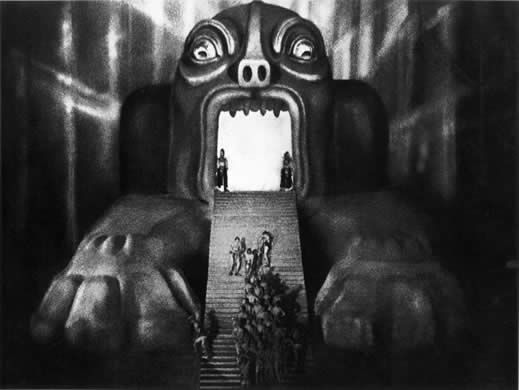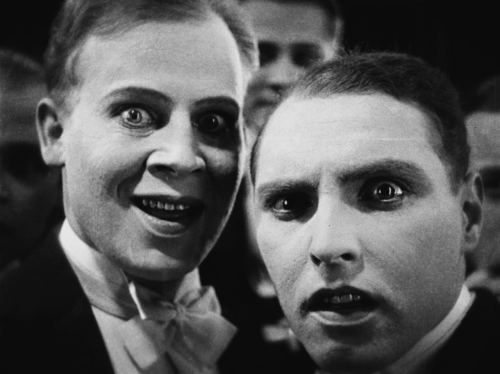Fig 1. Original Metropolis Poster
The film itself is a statement about industrialisation, and how humans can be both demonised, and objectified as tool's to keep an civilisation afloat, that could at any second collapse on itself if not maintained properly. The film takes place in two main locales; Above the ground in the titular city Metropolis where the upper classes live, and under the ground in the caverns and machine rooms where the worker's live who keep Metropolis running. Throughout the movie we are shown scene's where workers are in distraught, being seriously injured, and even killed by the machines they work at, just so that they can keep the city above running for the upper classes, at what appears to be no consequence or loss to anybody, as if this is a regular affair, or to the people above a necessary sacrifice for them to live their lifestyles. "For starters the geographical and sociological constructs of the film form a particular pattern familiar to those with even a passing knowledge of Judeo-Christian theology. The "metropolis" in question is built on a basis of horizontal stratification. The rich live in the uppermost levels: as the film puts it, "High in the heavens." The workers live in the depths of the mammoth city, far below the surface of the planet, where no natural light ever reaches." (Matthew, 2015)
Fig 2.
At one point he helps another worker who can barely stand after barely stopping his machine from melting down. He takes this workers place for the rest of his shift, and sends that worker in his clothes to the surface to get report back for him, but the worker is soon corrupted by money he finds in Freder's clothes, and is consumed by the pleasures the surface has to offer.
After Reuniting with Maria he is announced as the "Mediator", effectively the force that will unite the two social groups and end the suffering of the workers. This of course does not come without sufficient plot developments and obstacles in their way, one of which is the iconic moment that a doppel-ganger robot of Maria is made by the mad scientist Rotwang (Rudolf Klein-Rogge ) who's tasked with entering the workers society of ruining Maria's reputation with them, so they will no longer rebel as Freder's father has been fearing, she then runs amuck in the city, raising hell even bringing the men of the surface to murder out of lust.
The design of the robot that Maria's likeness is given too is iconic even to this day, having a strange steam punk like design to it, almost looking like an eventual inspiration for C-3PO from Star Wars' design, I could even recognise the robot before I'd seen the film purely from pop culture references.
"And, of course, what could be more expressionistic than the design of the Machine Man (which, in the parlance of the day, was called a Man despite its obviously feminine trappings)? That’s probably the image most people have of the film, even if they’ve only heard of it without ever seeing it." (Pick, 2015)
Bibliography:
"Matthew (2015): http://www.classicartfilms.com/the-complete-metropolis
"Vigilant Citizen" (2010):http://vigilantcitizen.com/musicbusiness/the-occult-symbolism-of-movie-metropolis-and-its-importance-in-pop-culture/
Steve, P (2015): http://www.popmatters.com/post/192532-double-take-metropolis-1927/
Illustration List:
Fig.1 (Poster) http://scifimoviefilms.com/unique-posters-metropolis-1927/
Fig.2 (Screenshot, Fritz Lang) http://forum.prisonplanet.com/index.php?topic=18700.0
Fig.3 (Screenshot, Fritz Lang) http://beautiful-grotesque.blogspot.co.uk/2012_11_01_archive.html
"And, of course, what could be more expressionistic than the design of the Machine Man (which, in the parlance of the day, was called a Man despite its obviously feminine trappings)? That’s probably the image most people have of the film, even if they’ve only heard of it without ever seeing it." (Pick, 2015)
Bibliography:
"Matthew (2015): http://www.classicartfilms.com/the-complete-metropolis
"Vigilant Citizen" (2010):http://vigilantcitizen.com/musicbusiness/the-occult-symbolism-of-movie-metropolis-and-its-importance-in-pop-culture/
Steve, P (2015): http://www.popmatters.com/post/192532-double-take-metropolis-1927/
Illustration List:
Fig.1 (Poster) http://scifimoviefilms.com/unique-posters-metropolis-1927/
Fig.2 (Screenshot, Fritz Lang) http://forum.prisonplanet.com/index.php?topic=18700.0
Fig.3 (Screenshot, Fritz Lang) http://beautiful-grotesque.blogspot.co.uk/2012_11_01_archive.html







Nice review Brad :)
ReplyDeleteJust be careful that you don't slip into using the 1st person, as you have done at the very end - use the 3rd person, and that way your writing stays academic-sounding. Also, just have another quick look at the referencing guide to make sure that your bibliography is set out as it should be -
http://community.ucreative.ac.uk/Harvard-Referencing
Ah, almost there, thank you Jackie ! :)
Delete